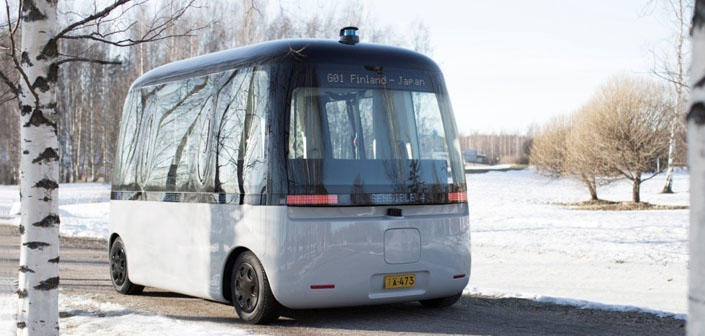Designed in a collaboration between Finnish autonomous driving company Sensible 4, Japanese company MUJI, and Robosense, the autonomous shuttle bus robo-taxi GACHA is the world’s first autonomous driving shuttle bus for all weather conditions.
Although autonomous cars are slowly becoming a reality, there are still various issues to solve, including their performance in poor weather conditions. In locations where winter temperatures can reach as low as -30°C (-22°F), these “can incapacitate the performance of semiconductor components, while snow and ice covered roads essentially cripple the image algorithms’ ability to determine abstract environment information”. Moreover, LiDAR sensors can fail to start-up or perform worse, reducing its detection accuracy and ranging.
For this reason, Sensible 4 and MUJI partnered with Robosense to equip GACHA with Robosense’s RS-LiDAR-16, a lidar sensor built for autonomous driving, robots environment perception and UAV mapping. The sensor features a 360º field-of-view, an accuracy of around 2cm, a scan range between 20cm and 150m (20% object reflectivity), and its 16 laser beams scan at a high data rate of 320,000 points/second.
However, the focus here is on the fact the RS-LiDAR-16 works “even at freezing temperatures of tens of Celsius degrees below zero,” said Harri Santamala, CEO of Sensible 4. Robosense’s cold-resistant lidar uses point cloud algorithms that accurately recognize obstacles, even in snow and ice.
“The GACHA development got started when the Sensible 4 team, working back then with the first generation of robot buses, noticed that they just don’t perform at all, even in light rain, not to mention the typical winter conditions in Finland,” Harri Santamala added. “Completely autonomous self-driving technology is not here yet. Most self-driving cars can operate only in ideal weather conditions and well-marked roads. This is what Sensible 4 has managed to change through repeated tests in the harsh winter conditions of the Finnish Lapland.”
There are other companies who are working on different sensing solutions for autonomous cars to work under adverse weather conditions, such as Wavesense. The company’s ground-penetrating radar (GPR) technology uses pulses of electromagnetic radiation to measure reflections that originate from scattering points below the surface and create a 3D map of the subsurface environment. Then, this map is used as a reference data-set to help estimate vehicle location on subsequent visits. According to eeNews Europe, Tarik Bolat, CEO and Co-Founder of WaveSense, said the technology could cost “under a hundred dollars at production scale”.
In April 2019, Robosense will join Sensible 4 on their first GACHA bus fleet deployment for use on public roads.
“I’m pleased that our product has helped Sensible 4 and MUJI’s jointly designed GACHA self-driving shuttle bus solve perception problems in all weather conditions. In the near future, all RoboSense multi-layer LiDAR products will be able to operate in automotive grade low temperatures under -40℃,” said Mark Qiu, COO, RoboSense.






